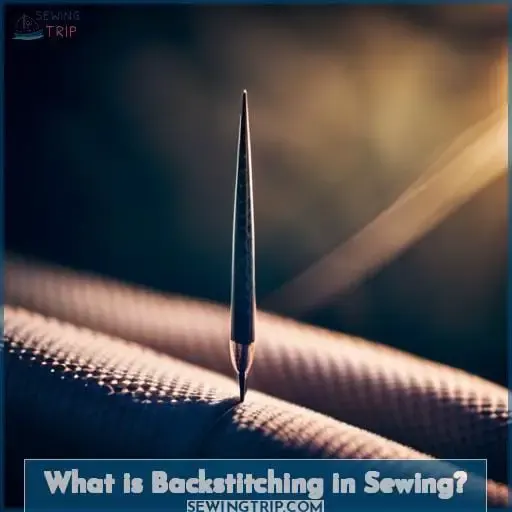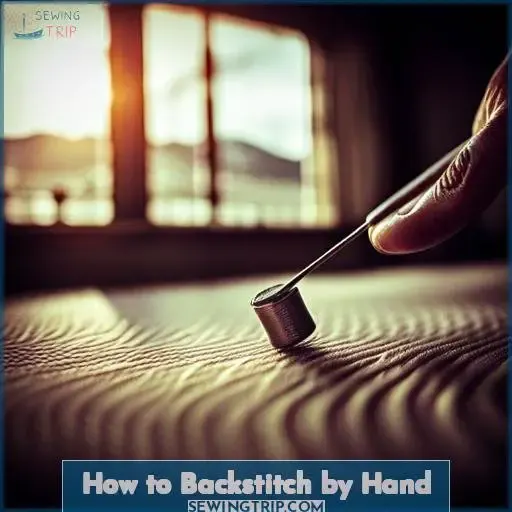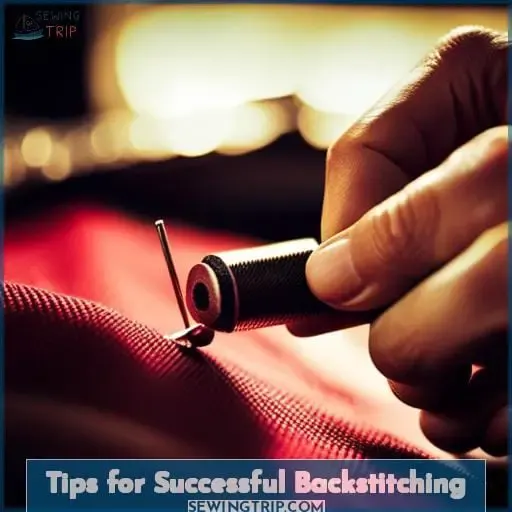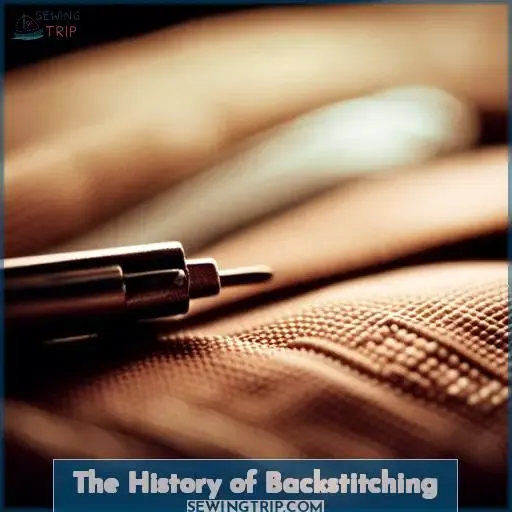This site is supported by our readers. We may earn a commission, at no cost to you, if you purchase through links.
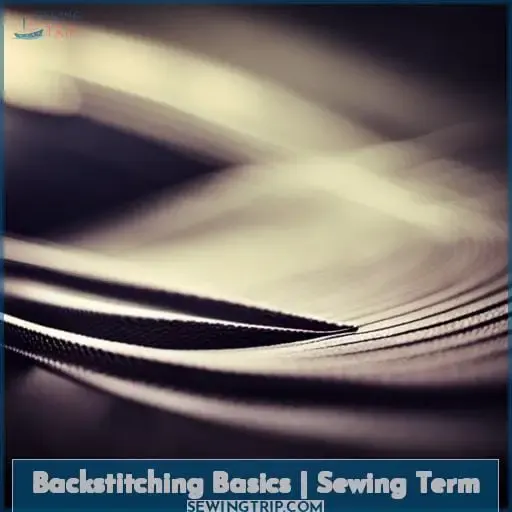 Discover the essential technique of backstitching in sewing.
Discover the essential technique of backstitching in sewing.
When you want to secure your stitches and prevent unraveling, backstitching is a must-know skill. By sewing one stitch backward on the front side and two stitches forward on the reverse side, you create a strong line of stitching that holds firm on both sides.
Whether you’re using a sewing machine or hand-sewing, mastering this basic stitch will give your seams durability and quality.
Get ready to elevate your sewing game with backstitching basics!
Table Of Contents
Key Takeaways
- Backstitching is a sewing technique that creates secure and durable seams by overlapping stitches.
- It can be done both by hand and with a sewing machine, with the machine often having a dedicated backstitch function.
- Backstitching has a long history and has evolved over time with changes in methods and tools.
- It has various applications and variations, including embroidery, decorative seam finishes, and artistic stitching.
What is Backstitching in Sewing?
Let’s dive into the concept of backstitching in sewing.
Backstitching is a technique used to secure stitches at the beginning and end of a seam, preventing unraveling and ensuring stability.
Definition and Purpose of Backstitching
Backstitching is the essential technique in sewing that ensures the stability and durability of your seams.
Whether done by machine or hand, backstitching involves creating stitches that move one stitch length backward on the front side and two stitch lengths forward on the reverse side.
Machines often have automatic features for backstitching, while hand stitching allows for more precision.
Proper thread preparation is crucial before starting a backstitch seam using a needle and thread.
Backstitching Techniques
To master the art of backstitching, familiarize yourself with different techniques that ensure secure and durable stitches.
- Machine backstitching: Sew 1-2 stitches forward, then put the machine in reverse for 1-2 stitches to secure the seam.
- Hand backstitching: Provides a straight line of stitching ideal for embroidery and preventing bunching.
- Backstitch examples: Used in repairing tears or creating solid lines on both sides.
- Backstitch history: Dating back to 1611, it has been used as a sewing technique for centuries.
Now that you understand what’s meant by backstitich, let’s dive into some specific techniques to help you perfect this essential sewing skill.
When using a sewing machine, there are specific steps involved in achieving an effective machine backstitch:
- Sew 1-2 stitches forward along your chosen seamline.
- Put your machine into reverse mode and sew backward over those same few stitches just made; aim to go one stitch length backward on the front side of fabric while going two stitch lengths forward through its’ underside.
On the other hand, if you’re opting for hand-stitched projects or need more precise control over your stitching:
- Start by threading needle with desired thread type (matching project).
- Begin at top corner where first stitch will be placed. Note It may also help mark area using pencil line guide before starting.
Next up are some examples showcasing how versatile this technique can be:
- Repair work: Whether fixing torn hems or reinforcing weak seams, employing well-executed rows ensures durability & longevity.
- Embroidery purposes: When seeking neat outlines & straight-line designs without visible knots.
Moving onto our next section — exploring historical significance behind such an influential sewing technique:
Backstitching has a rich history, with its origins dating back to 1611. Examples of the term’s usage can be found in context that aligns directly with the defined sewing technique.
For instance, according to Merriam-Webster.com Dictionary:
- Backstitch was first recorded as an official term in 1611.
- It refers specifically to creating a solid line on both sides (as opposed only one side).
In conclusion, by familiarizing yourself with various techniques and tips for machine and hand backstitching, you’ll have all necessary knowledge required to create secure stitches that will stand test of time.
Machine Features and Manual Guidance
Can you locate the backstitch feature on your sewing machine?
Understanding the machine features and manual guidance is essential for mastering backstitching in sewing projects.
Many machines have a built-in backstitch function, usually controlled by a lever or button.
Familiarize yourself with these functions to achieve precise and secure stitches at the beginning and end of your seams.
How to Backstitch by Hand
Now let’s dive into the process of backstitching by hand.
In order to achieve successful backstitches, you need to prepare your needle and mark your seam accurately.
Once you’ve initiated the first stitch, continue stitching with precision and maintain even tension throughout.
Finally, finish off the seam by overlapping threads and creating a secure anchor.
Needle Preparation and Seam Marking
Prepare your needle and mark the seam to begin backstitching by hand.
Start by threading a yard-long piece of thread through the needle, knotting the end securely.
For accurate stitching, use a ruler or short pencil marks to mark straight seams or curves on your fabric.
Connect these marks to create a guide for maintaining a straight seam while stitching.
With proper preparation and marking, you’ll be ready to start backstitching with precision and control.
Initiating the First Stitch
Now, let’s dive into the process of initiating the first stitch when backstitching by hand.
Start by pushing your needle into the fabric and bringing it back through both layers just in front of the knot.
Make sure to follow any marked lines for accuracy as you create that initial stitch, guiding your thread along smoothly.
Continuing the Stitch
Continue stitching by bringing the needle through the fabric, replicating the distance of the first stitch.
To maintain a straight line, follow your marked guide or ruler for accuracy.
Manage your thread by ensuring it stays taut but not too tight to allow smooth movement of the needle.
Progress with small, secure stitches using proper hand technique and adjust stitch length as needed for durability or speed.
Finishing the Seam
To ensure a secure and neat finish, overlap the threads and sew a few stitches on top of each other to create a secure anchor.
Control your needle carefully as you stitch in place, maintaining even thread tension throughout.
Choose appropriate knot techniques based on your fabric choice to ensure durability.
Remember that small stitches will provide added strength when finishing the seam.
Check the reverse side of your fabric to confirm that everything looks tidy and secure before trimming any excess thread for a polished final result.
Tips for Successful Backstitching
When it comes to successful backstitching, guidance and precision are key.
Use a thin pencil line as your guide for precise stitching and maintain a steady hand with even tension throughout the sewing process.
Additionally, adapt your stitch length based on the fabric type and project requirements, and don’t be afraid to practice on scrap fabric to refine your backstitching technique.
Guidance and Precision
Maintain guidance and precision in your backstitching technique by using:
- A thin pencil line for precise stitching
- Keeping a steady hand with even tension throughout the sewing process
Pay attention to stitch length, as shorter stitches provide more durability.
Practice hand control to ensure needle accuracy and achieve consistent results.
Balance the tension of your thread for smooth, professional-looking stitches.
Follow fabric guidance markers or use pins to keep your seam straight while backstitching with precision.
Adaptation and Practice
Keep in mind that successful backstitching requires adapting and practicing your technique to achieve optimal results.
To improve your skills, try practical exercises such as stitching on scrap fabric using different stitch variations.
Troubleshooting tips can help you address any issues you encounter along the way.
Additionally, explore creative applications of backstitching in your sewing projects to enhance their visual appeal.
Consider material considerations like fabric thickness and thread type for the best outcomes on both the front side and reverse side of your work.
The History of Backstitching
Let’s delve into the history of backstitching and discover its origins.
The term backstitch was first used in 1611, aligning with the defined sewing technique we know today. It involves creating a solid line on both sides, typically used for repairing tears or securing seams.
Examples of Backstitch in a Sentence
Now let’s dive into the examples of backstitch in a sentence and explore the fascinating history behind this sewing technique.
Backstitching creates a solid line on both sides, as seen in sentences like:
- Begin the backstitch approximately a quarter-inch below the tear.
- Progress towards the end by employing small, precise stitches.
Merriam-Webster defines backstitching as one backward stitch followed by two forward stitches. This technique has been used since 1611 to repair tears and create durable seams in sewing projects.
Word History
Learn about the history of backstitching, a sewing technique with origins dating back to 1611.
Evolutionary variations:
- Backstitch has evolved over time, adapting to different sewing needs and preferences.
- Backstitching holds cultural significance in various regions around the world, reflecting local traditions and customs.
- Technological advancements have influenced the way people use backstitch in their artistic creations.
Backstitch continues to stitch together fabric pieces across generations, connecting us with our rich sewing heritage while embracing new possibilities for creative expression through technological advancements and artistic adaptations influenced by regional cultures worldwide.
Dictionary Entries Near Backstitch
Continue exploring the history of backstitching by examining dictionary entries near the term.
While specific entries weren’t provided, it’s evident that backstitch has been a long-standing technique in sewing with various applications such as:
- Stitch variations
- Creative embroidery
- Seam reinforcement
Backstitching has also seen innovations throughout textile traditions. Its enduring presence showcases its significance in the world of sewing and its ability to provide strength and durability to stitched creations.
Cite This Entry
To understand the origins and development of backstitching, let’s dive into the history of this sewing technique.
Backstitching has evolved over time to become a versatile method used in various applications such as:
- Hand stitch variations
- Advanced embroidery
- Creative seam finishes
- Artistic stitching techniques
- Custom stitch patterns
Understanding why backstitch is essential when sewing can empower you with mastery over your projects. Engage with reader interactions and utilize resources like Amazon Associate for advanced search options in enhancing your skills.
Share and Subscribe
Don’t miss out on fascinating insights into the history of backstitching by subscribing to our newsletter.
Stay updated with technique variations, stitching innovations, creative applications, and advanced embroidery techniques.
Discover specialized patterns and unlock new possibilities in your sewing projects.
Our newsletter provides valuable information that will empower you to master the art of backstitching and take your sewing skills to the next level.
Subscribe now for exclusive content delivered straight to your inbox!
Frequently Asked Questions (FAQs)
Is backstitching necessary for every sewing project?
Backstitching isn’t necessary for every sewing project, but it’s highly recommended. It provides added strength and durability to seams, preventing unraveling and ensuring a secure finish.
Can backstitching be done on all types of fabric?
Yes, backstitching can be done on all types of fabric. It provides extra strength and stability to your seams, ensuring they withstand the test of time.
Are there any alternative techniques to backstitching?
Yes, there are alternative techniques to backstitching in sewing.
Some options include using a lock stitch or a running stitch.
These techniques can be used depending on the fabric type and desired outcome of your project.
How can I prevent my backstitching from puckering or bunching up?
To prevent puckering or bunching, ensure even tension while backstitching.
Use small, precise stitches and maintain a steady hand.
Experiment with different thread thicknesses and practice on scrap fabric for mastery.
Can backstitching be used for decorative purposes in addition to securing seams?
Backstitching can indeed be used for decorative purposes, allowing you to showcase your creative flair while ensuring the stability of seams.
Experiment with different thread colors and patterns to add a unique touch to your sewing projects.
Conclusion
To sum it up, backstitching is a fundamental technique in sewing that ensures the strength and durability of your stitches.
By sewing one stitch backward and two stitches forward, you create a secure line of stitching that prevents unraveling.
Whether you’re using a sewing machine or sewing by hand, mastering this skill is essential for high-quality seams.
Remember to practice precision and adaptability, and with time, you’ll become a pro at backstitching.
Elevate your sewing game with this essential technique!

